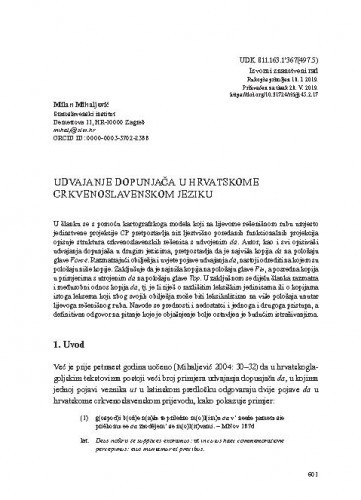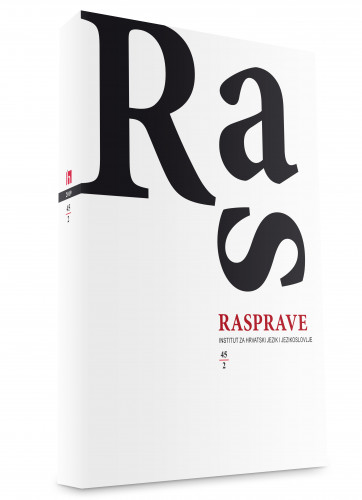U članku se s pomoću kartografskoga modela koji na lijevome rečeničnom rubu umjesto jedinstvene projekcije CP pretpostavlja niz ljestvično poredanih funkcionalnih projekcija opisuje struktura crkvenoslavenskih rečenica s udvojenim da. Autor, kao i svi opisivači udvajanja dopunjača u drugim jezicima, pretpostavlja da je najviša kopija da na položaju glave Force. Razmatrajući obilježja i uvjete pojave udvajanja da, nastoji odrediti na kojem su položaju niže kopije. Zaključuje da je najniža kopija na položaju glave Fin, a posredna kopija u primjerima s utrojenim da na položaju glave Top. U zaključnom se dijelu članka razmatra i međusobni odnos kopija da, tj. je li riječ o različitim leksičkim jedinicama ili o kopijama istoga leksema koji zbog svojih obilježja može biti leksikaliziran na više položaja unutar lijevoga rečeničnog ruba. Navode se prednosti i nedostatci i jednoga i drugoga pristupa, a definitivan odgovor na pitanje koje je objašnjenje bolje ostavljen je budućim istraživanjima.; In Croatian-Glagolitic texts Mihaljević (2003) noted a number of examples in which two or even three occurrences of the Church Slavonic word da correspond to only one occurrence of the Latin ut. In all such examples da has a typical role of a complementizer, i.e. it introduces complement, final or consecutive clauses. According to Slovník jazyka staroslověnského (1967: 453) double-da structures occured already in Old Church Slavonic Codex Suprasliensis. The author describes the structure of these Church Slavonic sentences using the so-called cartographic model, which assumes for sentence periphery to the left of the subject the existence of a number of hierarchically ordered functional projections, instead of a single CP projection. The phenomenon of complementizer doubling is attested and studied in different languages. It is generally assumed that the first instance of the complementizer is in Force, while the position of the second instance is disputable. Some authors assume that optional secondary complementizer is in Fin, while according to others it is in Top. The main goal of the paper is to determine which description is more adequate for Croatian Church Slavonic. The author investigates the conditions for the appearance of doubling, as well as the properties and the distribution of doubled da with respect to the left-peripheral phenomena, and concludes that the lowest copy of da heads FinP. This conclusion is confirmed by the following facts: no left-dislocated constituent can follow the lowest da, the doubling of da is possible only in irreal (subjunctive) contexts, and therefore the verb in the subordinated TP can only be in the present tense, conditional or imperative. Consequently, he assumes that in the triple-da constructions the intermediate copy of da is in Top.
Sažetak

 Rasprave Instituta za hrvatski jezik i jezikoslovlje 45,2(2019) / glavni urednik Željko Jozić.
Rasprave Instituta za hrvatski jezik i jezikoslovlje 45,2(2019) / glavni urednik Željko Jozić.